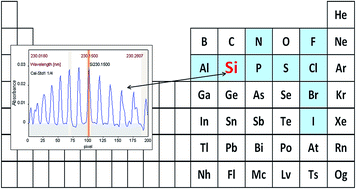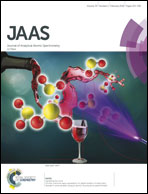Feasibility of high-resolution continuum source flame molecular absorption spectrometry for silicon determination in organic solutions via the SiO molecule
Abstract
In this work, for the first time, Si determination via absorption by its diatomic molecule is proposed. High-resolution continuum source flame molecular absorption spectrometry (HR-CS FMAS) was applied with SiO as a target molecule generated during aspiration of xylene solutions of organic Si compounds into an air–acetylene flame. The registered absorption spectra composed of many, primarily well-resolved, rotational lines that belong to various sequences of the X1Σ+ → A1Π electronic transition of the SiO molecule. To select the spectral range for analysis, sequential measurements in the area of the most intensive SiO molecule absorption were executed. Under the selected conditions (spectral range in the vicinity of the 230.150 nm rotational line, iterative background correction and 5 pixels for analyte signal evaluation) the characteristic concentration of Si determination is 14.9 mg L−1 for octamethylcyclotetrasiloxane and 3.2 mg L−1 for hexamethyldisiloxane, while the detection limit is 0.92 mg L−1 and 0.20 mg L−1, respectively. The integration of absorbance for selected pixels belonging to various rotational lines improves detectability only insignificantly. The option of integration of absorbance of pixels belonging to the single rotational line is preferable due to the lack of overlaps by lines from interferents (Ni, Fe, S). Under the selected conditions, no additional signals were distinguished for solutions containing N or P. The effect of chemical character due to the competition of S to form the SiS molecule was not observed. On the other hand, even though the investigated 230.150 nm line is located between two rotational CS lines, some overlapping of the spectra of SiO and CS molecules was observed. Least squares background correction (LSBC) was helpful to overcome the interference. The detectability of the proposed method of Si determination is about one order of magnitude worse than for the appropriate atomic absorption method. However, the possibility for usage of ordinary air–acetylene flame instead of N2O–C2H2 flame is very attractive. The achieved detectability of Si determination is better than in the case of literature data for all the other elements determined using HR-CS FMAS. Volatile organic compounds are recommended for the generation of reference spectra of diatomic molecules in HR-CS MAS.



 Please wait while we load your content...
Please wait while we load your content...